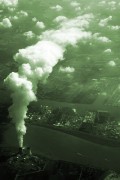 Not being one to shy away from controversy (viz. my MMR and vaccination item, the intelligent Dawkins debate post and the recent flurry of global warming items, including one entitled Climate change debunked), I thought I’d dive headlong into the muddy ethical, economic, and engineering puddle that is nuclear power.
Not being one to shy away from controversy (viz. my MMR and vaccination item, the intelligent Dawkins debate post and the recent flurry of global warming items, including one entitled Climate change debunked), I thought I’d dive headlong into the muddy ethical, economic, and engineering puddle that is nuclear power.
However, I am wearing a buoyancy aid, a nose-clip, ear-plugs, and protective goggles in the form of a peer-reviewed review from the International Journal of Global Energy Issues (2008, 30, 393-412), rather than skinny dipping.
In that paper, John Cleveland of the International Atomic Energy Agency, in Vienna, points out that currently nuclear power produces around 15 percent of the electricity we use worldwide. This time last year, there were 438 nuclear power plants providing more than 370 Gigawatts with 31 new units under construction looking to add 24 GW to that total, although with a few being decommissioned in the meantime.
Cleveland explains that several countries are planning to either introduce nuclear energy or expand their nuclear generation capacity, and that most of the new plants will be of evolutionary, rather than innovative design. They will incorporate improvements over existing electricity generating nuclear plant designs achieved through small to moderate modifications, with a strong emphasis on maintaining proven design features to minimize technological risks. Cleveland suggests that in the longer term, innovative new designs will help to promote a new era of nuclear power.
He argues that the increasing demand for power both in the industrialized and developing world, together with nuclear power’s positive attributes, provide a solid rationale for expanding nuclear power sources:
- Nuclear power’s lengthening experience and good performance. The industry now has more than 12,000 reactor years of experience, and the global average nuclear plant availability during 2006 reached 83%
- Growing energy needs. All forecasts project increases. The strategies are country dependent, but usually involve a mix of energy sources
- Interest in advanced applications of nuclear energy, such as seawater desalination, steam for heavy oil recovery and heat and electricity for hydrogen production
- Environmental concerns and constraints. The Kyoto Protocol has been in force since February 2006, and for many countries (most OECD countries, Russia, the Baltic nations and some countries of the Former Soviet Union and Eastern Europe) emissions limits are imposed
- Security of energy supply is a national priority in essentially every country
- Nuclear power is economically competitive and provides stability of electricity price.
He adds that nuclear power faces significant challenges, nevertheless, including the continuing need to sustain a high level of safety assurance, implementing high-level waste disposal, and strengthening the nuclear non-proliferation regime.
Success in these areas will provide a sound basis for establishing nuclear power as a sustainable energy source.
Evolutionary nuclear plants that utilise the best of current systems are already being built in several countries, and, adds Cleveland, are likely to be the primary choice for the next decade or two. Innovative, nuclear plants, are a different matter. In general they will require a new design paradigm, construction and testing of a prototype, and then a pilot plant before commercialisation, and so may not be implemented until about the second quarter of this century.
Several innovative designs are being developed for the Small- to Medium-Size Reactor (SMR) range and could find their introduction into the increasingly power hungry developing nations, as well as in some cases into industrialized countries. In developing countries, boosting self-reliance, keeping costs down, and enhancing local work force participation and participation of the domestic industry could be important factors for the governments of those nations to pursue.